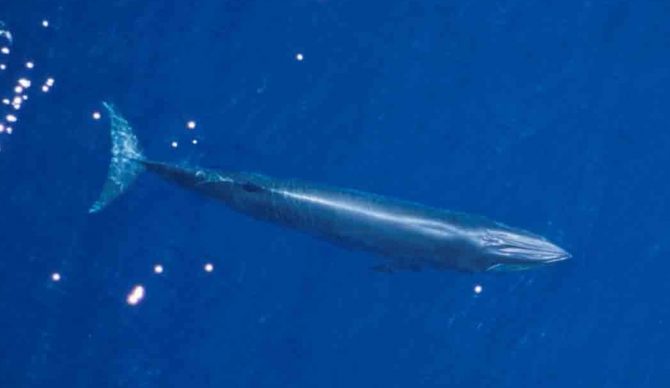For nearly a decade, a strange sound from the depths of the Mariana Trench had baffled scientists. The sound, dubbed the “biotwang,” reverberated through the vast, dark waters of the deepest part of our planet, leading to wild speculation about its origins. Some imagined it as a signal from extraterrestrial beings or undiscovered sea monsters lurking in the ocean’s abyss. Thanks to groundbreaking research, scientists have finally solved this marine mystery. As it turns out, the sound is neither alien nor monstrous but rather an odd call from one of Earth’s most enormous creatures: the Bryde’s whale.
A sound that stumped scientists
The Mariana Trench, located in the western Pacific Ocean, is a colossal undersea feature spanning more than 1,500 miles and plunging nearly seven miles into the ocean’s depths. 2014 autonomous gliders were sent into the trench to capture acoustic data. What they picked up was completely unexpected: a sound that came in two distinct parts—a low, deep moan followed by a sharp, metallic twang. This peculiar noise became known as the “biotwang,” its source puzzled researchers for years. At first, the sound was mistakenly attributed to Minke whales, whose unique “Star Wars” call had been previously recorded in other parts of the ocean. The resemblance was enough for scientists to make the initial connection. However, as further research continued, it became clear that something wasn’t quite right. The biotwang had a peculiar pattern that didn’t perfectly match any known Minke whale vocalizations, leading scientists back to square one.
It wasn’t until 2023 that scientists, using a combination of advanced technology and patience, finally cracked the case. The solution came, in part, thanks to artificial intelligence (AI). A team of researchers led by Dr. Ann Allen from the National Oceanic and Atmospheric Administration (NOAA) sifted through over 200,000 hours of audio recordings collected from underwater monitoring stations. The AI was able to identify and isolate the biotwang sound, analyzing its acoustic properties with precision. The breakthrough occurred when the researchers observed a group of Bryde’s whales near the Mariana Islands.
Out of the ten whales they tracked, nine of them were recorded making the distinctive biotwang call. This significant finding led Dr. Allen to remark, “Once, it’s a coincidence. Twice is happenstance. Nine times, it’s a Bryde’s whale.” But how could scientists be so sure? The team didn’t just rely on visual confirmation. Using AI, they cross-referenced years of audio recordings with known migration patterns of Bryde’s whales. The biotwang, they discovered, aligned perfectly with the movement of these whales, cementing their role as the mysterious sound-makers of the Mariana Trench.

The role of AI in unravelling the sound
What makes this discovery particularly fascinating is the role of AI in solving the puzzle. Traditional methods of analyzing ocean sounds are time-consuming and labour-intensive, requiring human experts to sift through vast amounts of audio data manually. With the help of AI, scientists were able to speed up this process dramatically. The AI converted the biotwang into visual spectrograms—images that represent sound frequencies over time. This allowed the researchers to quickly differentiate the biotwang from other ocean noises, streamlining the entire process. The use of AI tools in marine biology is still a relatively new frontier, but it’s proving to be a game-changer. By automating parts of the research process, scientists can focus on deeper analysis and make breakthroughs faster. In this case, AI was critical in identifying a previously elusive sound in one of the most remote parts of the world.
Why do Bryde’s whales make the biotwang?
Although the mystery of the biotwang’s source has been solved, one question remains: Why do Bryde’s whales make this strange sound? The answer is still up for debate, but scientists have some educated guesses. One prevailing theory is that the biotwang serves as a contact call for whales to communicate over vast distances in the deep ocean. Dr Allen likens it to a marine version of the classic “Marco Polo” game where one whale calls out, and others respond. This theory is bolstered by the fact that Bryde’s whales are known to be highly social animals that use vocalizations to stay connected with one another.
However, it’s also possible that the biotwang serves a different purpose, such as attracting mates or asserting dominance. Since the biotwang appears to be specific to a population of Bryde’s whales living in the northwest Pacific, it could represent a regional dialect—a unique way for these particular whales to communicate. Further research is needed to understand the full range of Bryde’s whale vocalizations, as well as the contexts in which they use them. However, with the tools at scientists’ disposal, including AI and acoustic monitoring technology, we’ll likely have more answers in the coming years.
The discovery of the biotwang’s origin offers a fascinating glimpse into the mysterious world of the deep sea. The Mariana Trench is one of the least explored places on Earth, largely because of its extreme depth and the technical challenges of reaching it. Only a handful of expeditions have ventured into the trench, and discovering new species and phenomena is common. The biotwang mystery reminds us of just how much we have yet to learn about the ocean’s depths. The deep sea is home to some of the planet’s most unusual creatures and behaviours, many of which remain undiscovered. Each new finding, whether it’s a new species or a strange sound, adds to our understanding of the complex ecosystems that exist miles beneath the ocean’s surface.



